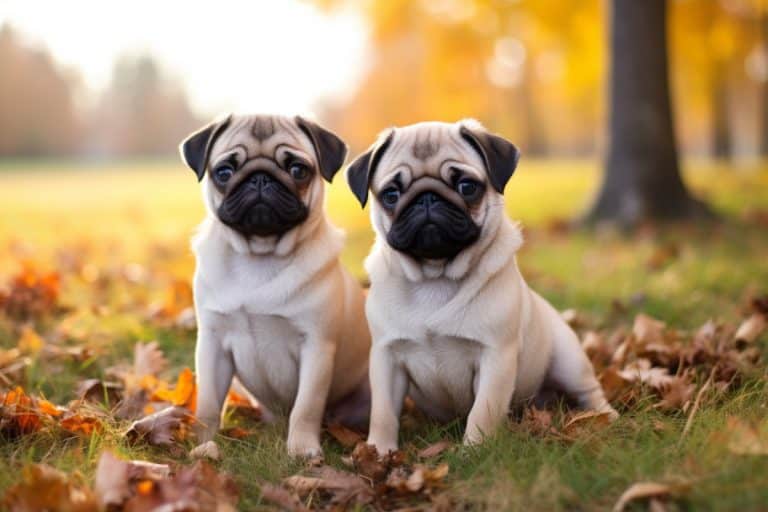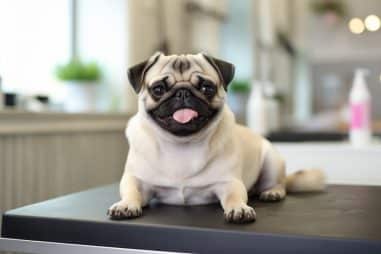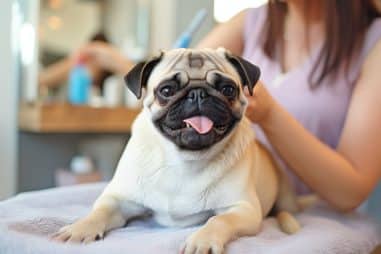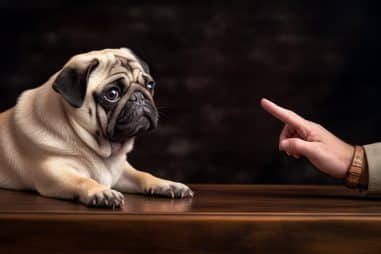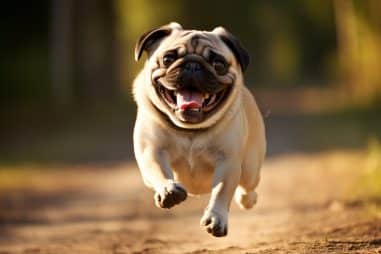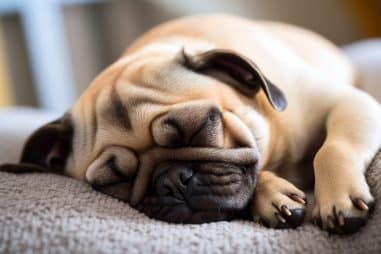Pugs are cute and cuddly, and have a unique charm that makes them loved by many. But, like all dog breeds, pugs have their own reproductive cycle. Understanding this cycle is essential for any pug owner, whether you’re looking to breed your dog or just want to ensure her well-being. In this article, you’ll learn everything you need to know about your pug’s heat cycle.
What Is a Heat Cycle?
Now, you might wonder, what exactly is a heat cycle? In simple terms, a heat cycle is the period when a female dog can become pregnant. During this time, you’ll notice some changes in your pug’s behavior and physical appearance.
For example, your pug might become more affectionate, or you might see some spotting. These are signs that she is in heat. Knowing these signs can help you take better care of your pug during this time.
How Often Do Pugs Go Into Heat?
So, how often does this cycle happen? For most pugs, they go into heat about once every six months. However, some factors can influence this.
Age
Younger pugs might not have established a regular heat cycle yet. Typically, a pug will have her first heat cycle between 6 to 12 months of age. As she grows older, her heat cycles may become more predictable and regular.
Health and Nutrition
A pug’s overall health can influence her heat cycle. Dogs that are malnourished or have certain health conditions might experience irregular or even missed heat cycles. It’s important to ensure your pug has a balanced diet and regular checkups to maintain optimal health.
Weight
Being significantly underweight or overweight can impact the regularity of a pug’s heat cycle. Excess weight can cause hormonal imbalances, leading to irregular cycles.
Climate and Season
Some believe that the changing of seasons can influence when a pug goes into heat. While pugs can go into heat at any time of the year, some owners notice a pattern that aligns with specific seasons.
Presence of Other Dogs
Being around other female dogs might influence when a pug goes into heat. There’s a phenomenon called “silent heat” where the signs are not evident, and this can sometimes be triggered by the presence of other dogs.
Breeding History
Pugs that have been bred previously might experience changes in the regularity of their heat cycles.
Stress
Significant changes in a pug’s environment, moving homes, or other stressors can potentially delay or even skip a heat cycle. It’s important to keep the environment stable and stress-free as much as possible.
In conclusion, while the average is for pugs to go into heat twice a year, several factors can influence this. If you’re concerned about your pug’s heat cycle, it’s always a good idea to consult with a veterinarian to ensure her health and well-being.
How Long Do Pugs Stay in Heat?
The heat cycle doesn’t last forever. It’s typically a few weeks long. There are different stages to this cycle, each with its own set of signs. The entire cycle can last anywhere from 2 to 4 weeks (14 to 28 days). During this time, it’s important to keep an eye on your pug and make sure she’s comfortable.
When Is the Best Time for Pugs to Mate?
If you’re thinking about breeding your pug, knowing the right time is essential. The fertile period within the heat cycle is usually around the 9th to 12th day. You’ll know she’s ready when she becomes more playful with male dogs. But remember, if you’re not planning on breeding, it’s best to keep her away from male dogs during this time.
When to Neuter Pugs
Neutering is the process of surgically removing the reproductive organs of an animal. For male dogs, including pugs, this means removing the testicles. Neutering has several health and behavioral benefits, but timing is crucial. Let’s explore the best times and reasons to neuter your pug.
Benefits of Neutering
Before diving into the timing, it’s essential to understand why neutering can be beneficial:
- Population Control: Neutering helps control the pet population. Unwanted litters can be a significant concern, leading to more dogs in shelters.
- Behavioral Benefits: Neutered pugs might be less aggressive, less prone to marking territory, and less likely to roam in search of a mate.
- Health Benefits: Neutering can reduce the risk of certain diseases, including testicular cancer.
Ideal Age for Neutering
The best age to neuter a pug can vary based on various factors, but here are some general guidelines:
- Puppy Stage: Many veterinarians recommend neutering dogs between the ages of 6 to 9 months. At this age, pugs are typically mature enough to undergo the procedure but have not yet reached sexual maturity.
- After First Heat: Some vets might advise waiting until after a female pug has her first heat cycle to neuter. This typically happens around 6 to 12 months of age. Waiting can have potential health benefits for female pugs, but there’s also a risk of unplanned pregnancy during this period.
- Adult Pugs: If for some reason, you didn’t neuter your pug during the puppy stage, it’s still beneficial to consider the procedure during adulthood. The earlier in life, the better, but even older pugs can be neutered to prevent unwanted litters and reduce health risks.
Things to Consider
- Health: Always get a full health checkup for your pug before neutering. This ensures that they are fit for surgery.
- Recovery Time: After the procedure, pugs will need some recovery time. Ensure you have a comfortable space for them and monitor them for any signs of discomfort or complications.
- Consult with a Veterinarian: Every pug is unique. It’s essential to have a conversation with your vet about the best time to neuter your specific dog, taking into account their health, size, and any other individual considerations.
In summary, neutering is a responsible choice for pug owners. The timing can vary, but understanding the benefits and consulting with a vet can help you make an informed decision for your furry friend’s well-being.
Potential Health Concerns During the Heat Cycle
Pugs, with their distinctive flat faces and compact bodies, have some unique health considerations. When it comes to their heat cycle, there are particular concerns that pug owners should be aware of to ensure their pet’s well-being. Here’s a breakdown of potential health issues that pugs might face during their heat cycle:
1. Brachycephalic Syndrome
While this isn’t directly related to the heat cycle, the physical exertion and increased stress during this period can exacerbate breathing problems in pugs. Their short noses can make breathing challenging, especially if they become overly excited or stressed.
Tip: Ensure your pug has a cool and calm environment during her heat cycle. Avoid strenuous activities, especially in hot weather.
2. Vulnerability to Infections
Pugs are prone to vaginal infections during their heat cycle. The increased discharge provides a medium where bacteria can thrive.
Tip: Keep your pug’s rear end clean. Regularly check for signs of infections, like excessive redness or an unpleasant odor.
3. Pyometra
This is a severe infection of the uterus that can occur after the heat cycle. Pugs, like other breeds, are at risk. Symptoms include increased thirst, frequent urination, and a swollen abdomen.
Tip: If you suspect your pug has pyometra, it’s essential to consult a veterinarian immediately. This condition can be life-threatening if not treated.
4. False Pregnancy
After a heat cycle, some pugs might show signs of pregnancy, even if they aren’t pregnant. This can include nesting behavior, weight gain, and even milk production.
Tip: While this isn’t necessarily harmful, it can be distressing for your pug. Consult with a vet to understand and manage these symptoms.
5. Overheating
Pugs are more susceptible to heatstroke than other breeds due to their facial structure. The physical changes and stress during the heat cycle can make them even more vulnerable.
Tip: Always ensure your pug has access to fresh water and a cool place to rest. Avoid long walks during hot parts of the day.
6. Unwanted Pregnancy
Pugs in heat are at risk of unwanted pregnancies if they come into contact with intact males.
Tip: Be vigilant about where and when you take your pug out. Consider keeping her indoors during the peak of her cycle to avoid accidental mating.
7. Mood Swings
Like many dogs in heat, pugs can experience mood swings. They might become more affectionate, or, in contrast, more irritable.
Tip: Be patient with your pug during this time. Ensure she has her own space where she can retreat and relax.
In conclusion, while the heat cycle is a natural process, pugs have specific health concerns that owners should be mindful of. Regular checkups with a vet, along with attentive care at home, can help ensure your pug stays healthy and happy during her heat cycle.
Conclusion
Understanding your pug’s heat cycle is a big part of responsible pet ownership. By knowing the signs and stages, you can ensure her comfort and health. Whether you’re planning on breeding or just want to keep her happy and healthy, this knowledge is power. So, always stay informed and provide the best care for your furry friend.

